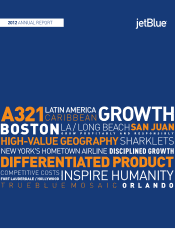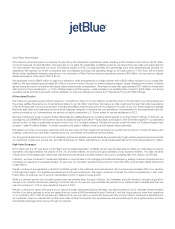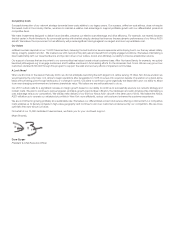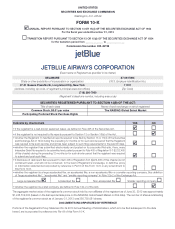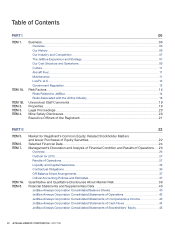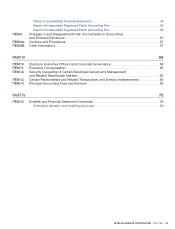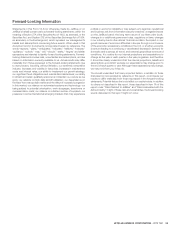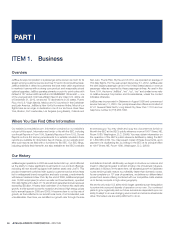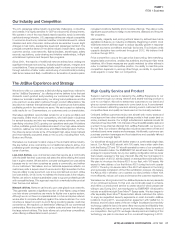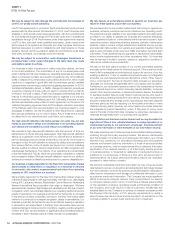JetBlue Airlines 2012 Annual Report Download - page 11
Download and view the complete annual report
Please find page 11 of the 2012 JetBlue Airlines annual report below. You can navigate through the pages in the report by either clicking on the pages listed below, or by using the keyword search tool below to find specific information within the annual report.
PART I
JETBLUE AIRWAYS CORPORATION-2012 10K 07
ITEM 1Business
Our Industry and Competition
The U.S. passenger airline industry is extremely challenging, competitive
and volatile. It is highly sensitive to GDP and economic developments.
We operate in one of the most heavily taxed industries, which is extremely
capital and energy intensive. U.S. passenger airlines are uniquely susceptible
to economic downturns, inclement weather, international events, natural
disasters and acts of terrorism. Airline returns are sensitive to even slight
changes in fuel costs, average fare levels and passenger demand. The
principal competitive factors in the airline industry include fares, capacity,
customer service, route networks, fl ight schedules, aircraft types, safety
records, reputations, code-sharing and interline relationships, in-fl ight
entertainment systems and frequent fl yer programs.
Since 2001, the majority of traditional network airlines have undergone
signifi cant fi nancial restructuring, including bankruptcies, mergers and
consolidations. These processes typically result in a lower cost structure
through reduction of labor costs, restructuring of commitments (including
debt terms, leases and fl eet), modifi cation or termination of pension plans,
increased workforce fl exibility and innovative offerings. They also provide
signifi cant opportunities to realign route networks, alliances and frequent
fl ier programs.
Historically, capacity and pricing actions taken by airlines have had a
signifi cant infl uence on industry profi tability. Beginning in 2008, most
traditional network airlines began to reduce capacity growth in response
to weak economic conditions and high fuel costs. This industry wide
capacity discipline has continued throughout 2012. We believe it will
continue through 2013.
Price competition occurs through price discounting, fare matching,
targeted sale promotions, ancillary fee additions and frequent fl yer travel
initiatives. All of these measures are usually matched by other airlines in
order to maintain their competitive position. Our ability to meet this price
competition depends on, among other things, our ability to operate at
costs equal to or lower than our competitors.
The JetBlue Experience and Strategy
We strive to offer our customers a distinctive fl ying experience, referred to
as the “JetBlue Experience”, by offering what we believe to be the best
domestic coach product and providing our customers high value. We
believe our success is evidenced by our strong brand preference and the
price premium we are able to achieve through product differentiation. We
also strive to maintain fi nancial strength and a cost structure that enables
profi table growth in the markets we serve. We are focused on delivering
solid results for our Crewmembers, our customers and our shareholders.
We believe signifi cant opportunities remain for us to grow profi tably and
responsibly. Unlike most of our competitors, who have been in business
for several decades and who are managing mature networks, we have
been fl ying only since 2000, growing our operations each year. We believe
further profi table growth is possible as a result of our high-value network
locations, relative low cost structure and differentiated product. Further,
the cities we serve include some of the largest high-value travel markets
and most densely populated areas in the country, including New York,
Boston and Florida.
We believe our business model is unique in the domestic airline industry.
We are neither a low-cost airline nor a traditional network airline. Our
profi table growth strategy enables us to compete effectively with both
types of carriers.
Low-Cost Airlines. Low-cost carriers view their service as a commodity
with the belief that their customers will select the airline offering the lowest
fare in a given market. We are able to compete well against low-cost airlines
because we do not view ourselves as purely a commodity, and neither
do our customers. We believe, and our historical experience refl ects, our
customers prefer a superior level of service and in-fl ight amenities. Further,
they are willing to pay a premium over a low-cost airline’s product. Unlike
low-cost airlines, we do not try to maintain the lowest costs in the industry.
Rather, we strive to achieve sustainable costs to support profi table growth
with competitive fares. This approach results in a markedly better product
than the low-cost airlines.
Network Airlines. Network carriers rely upon vast global route networks.
They generally operate a signifi cant portion of their fl ights using at least
one hub where connections are made for fl ights over a spoke system.
Although we do not have a comparable sized or a hub-and-spoke network,
we are able to compete effectively against the network airlines. Our route
structure is based on point-to-point fl ying providing greater customer
convenience. We expand our destination offerings via our commercial
partnerships. More importantly, our relative costs are lower than those of
the large network airlines. This factor allows us to price fares competitively,
while offering a differentiated coach product.
High Quality Service and Product
Superior customer service in delivering the JetBlue Experience to our
customers through our strong network and award-winning product is
core to our mission. We look to attract new customers to our brand and
give our current customers reasons to come back to us. A core element
of our success in attracting new and retaining current customers is that
competitive fares and quality air travel need not be mutually exclusive.
Onboard JetBlue customers enjoy new aircraft with roomy seats and
more legroom than other domestic airlines provide in their coach (and on
some, premium) service. Our in-fl ight entertainment systems include 36
channels of free DirecTV®, 100 channels of free SiriusXM satellite radio and
premium movie channel offerings from JetBlue Features®, our source of
fi rst run fi lms. Our onboard offerings also include an assortment of free and
unlimited brand name snacks and beverages. Additionally, customers can
purchase premium beverages and food selections and specially-tailored
products for overnight fl ights.
Our aircraft are all equipped with leather seats in a comfortable single class
layout. Our Airbus A320 aircraft, with 150 seats, has a wider cabin than
both the Boeing 737 and 757 aircraft operated by many of our competitors
on their domestic routes. Our EMBRAER 190 aircraft each have 100 seats
arranged in a space friendly two-by-two seating confi guration and are wider
than industry average for this type of aircraft. We offer the most legroom in
the main cabin of all U.S. airlines (based on average fl eet-wide seat pitch).
We plan to introduce the Airbus A321 to our fl eet, with 190 seats. We
expect to take delivery of our fi rst Airbus A321 during the fourth quarter
of 2013. The entry into service date of the A321 will depend on the timing
and successful completion of the FAA certifi cation process. We believe
the Airbus A321 will allow us to operate our slot portfolio in New York
more effi ciently, reduce unit costs and enhance the customer experience.
We believe our strong brand and the JetBlue Experience are key elements
of our continued success. To that end, we continually seek to enhance
and refi ne our product and service to create value for which people are
willing to pay. During 2012, we reconfi gured our EMBRAER 190 aircraft to
include an additional eight Even More™ Space seats. We also began to
offer separately Even More™ Speed which allows customers the option
to enjoy an expedited security experience in most domestic JetBlue
locations. During 2011, we executed an agreement with ViaSat Inc. to
develop and introduce state of the art in-fl ight broadband connectivity
technology called Ka-band. Ka-band offers more speed and fl exibility than
the existing Ku-band and air-to-ground technologies offered by some of
our competitors. During 2012, we began development and testing of this
technology; we plan to introduce wi-fi on our aircraft beginning in 2013.

